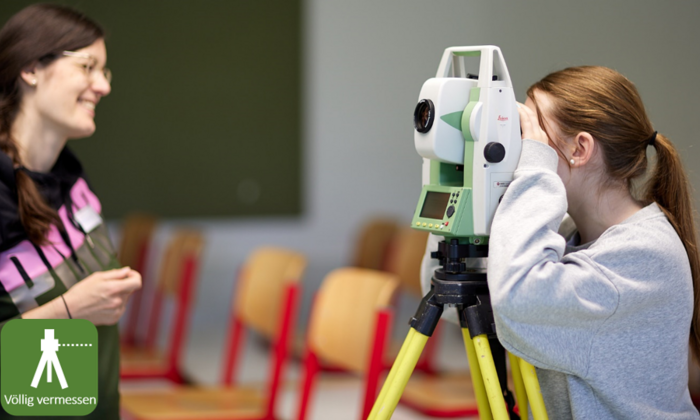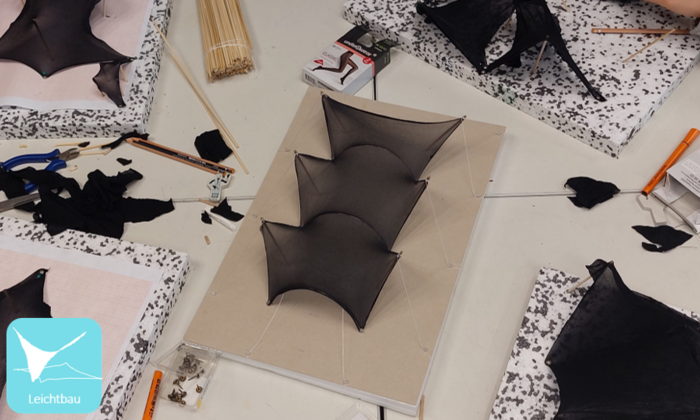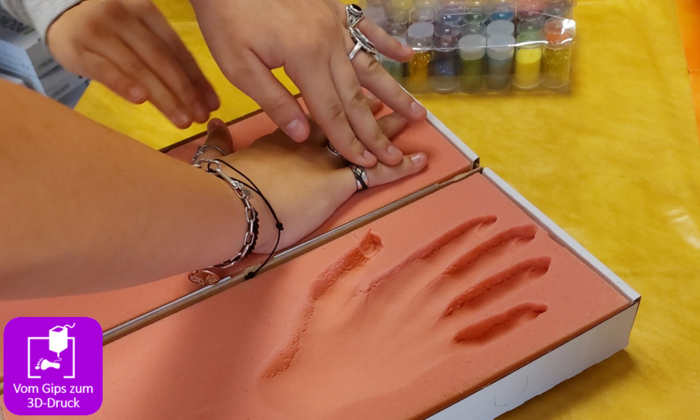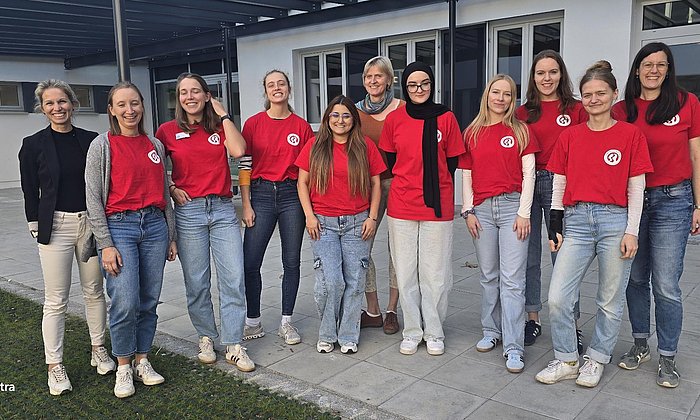Current MINT-Impulse projects
The MINT-Impulse projects cover a wide range of excititng topics. The schoolgirls can work on these under intensive supervision (maximum of 12 girls per project, plus 2 to 3 TUM instructors) on project days at our partner schools, design digital plans and also do manual work.
A secret matter - security in information technology
Without encryption, nothing would work today. No money withdrawals, no WhatsApp messages. But how did it all start? In this project, the students deal with various encryption techniques, in particular with the functioning of the Enigma, an electromechanical encryption machine that was also used in the Second World War. Various encryption techniques are learned and tried out. An introduction to the basics of electrical engineering with circuit diagrams and circuit symbols is followed by soldering and assembling your own functioning mini-Enigma. In the afternoon, the group learns how to encode and decode with their own machine. The project team’s message: “We check whether chips only contain what they are supposed to, so that you can send your daily messages safely. Because we love electrical engineering, we look forward to working with you for a day.”
In general, I find the collaboration, the testing and the assembling really nice and interesting.
Participant in the encryption technology project
Totally of the scale! - Engineering Geodesy
Google Maps, navigation systems, satellites - what would we do without them! But how does it actually work? What did people do before all this existed? After all, there were already global trade routes in the past. On the school project day, we try out various surveying devices and do lots of practical exercises: from ancient Egyptian measuring ropes to modern total stations and laser scanners. At the end, the pupils can draw their own map. The project consultants are engineering geodesists - the kind of people you find on all construction sites. Without them, all the buildings would be quite skewed and there wouldn't be a single tunnel. So, take a look at geodesy!
Environmentally friendly heating from the earth's interior! - Geothermal energy
Even the ancient Romans used hot springs to relax in thermal baths. However, we can also use thermal water from the Earth as renewable energy for heating - this is called geothermal energy. If we want to master the energy transition, we will have to run one in four heating systems with geothermal energy in 20 years' time. How do we find enough thermal water in the region for this and how (deep) can we actually drill into the Earth? On the project day, the pupils take on the role of energy suppliers in their community and ensure that nobody has to freeze next winter. To do this, they will solve a few puzzles about rocks, water and heat transfer before climate change endangers our habitat. The project team is part of the Geothermal Alliance of Bavaria and is researching geothermal energy in Bavaria so that we can heat our homes with renewable energy as quickly as possible. Dear students, join us in discovering geothermal energy and its possibilities for a climate-friendly energy supply!
Programme your own mini-robots! - Computer science
Computer science is everywhere these days. Computer science? - Aren't they just nerds who sit in front of a computer all day programming and doing nothing else at all? Far from it! Computer science requires an understanding of programming, but also a lot of creativity for new project ideas, product design and an understanding of people in order to recognize what users need and what is missing in the world. All of this is computer science. Pupils in this project are getting into computer science with us from the ground up. We make binary bracelets, look at where computer science plays a role everywhere and get an introduction to programming with “Swift Playground”. In the afternoon, the girls can come up with a topic for their own app and program it themselves. The project team of computer scientists from the Technical University of Munich looks forward to showing you that computer science is so much more than just sitting in front of a computer: “We are looking forward to discovering the different sides of computer science with you in a playful way and proving that female power is very important in this field. By the way, you don't need any previous knowledge!”
From the soap bubble to the Olympic stadium! - Lightweight construction
I'm sure many schoolgirls are familiar with the Olympic Stadium in Munich, with its transparent tent roof, which seems to float above the stands with impressive lightness. You have probably also heard that roofs collapse under the weight of snow if they are not built sturdily enough. In the lightweight construction project, the students look at how to construct roofs that are as light as possible but stable and attractive using very little material. The project group gets a taste of the entire design process for a lightweight roof. In the interplay of forces and geometry, the girls use models to find the right shape for their own roof and experience how a 1 mm thick textile can be used to stretch a roof over 100 meters. They work both manually and digitally with professional programs on the computer. The civil engineers in the project team enjoy working with unusual lightweight structures that impress with their variety of shapes and also offer resource-efficient solutions: “We look forward to designing your roof together with you in a creative form-finding process!”
Macromolecular Chemistry
Hardly any other class of material is discussed as much as plastics. Whether smartphones, space travel or flummies, stationery, cosmetics or furniture - it is probably impossible to imagine life without plastics today. But how are they actually produced? What does it take and, above all, how do their different properties come about? In this project, we want to find out together how diverse plastics are and what possibilities there are for producing plastics from renewable raw materials. The pupils can produce various plastics themselves with us and examine the different properties. At the end, they can take their self-made plastic home with them. The project team consists of chemists from the Wacker Chair of Macromolecular Chemistry and enjoy working on bio-based plastics, into which they sometimes incorporate CO2. They are interested in the entire process, from the monomers to the catalysts for the reactions and the properties of our polymers: “We look forward to experimenting with you in the lab for a day!”
The billiard hypothesis - Mathematics
Ellipses can be found everywhere. But what exactly characterizes ellipses and why do we need them? This workshop is all about the elliptical shape. In this project, the pupils draw, calculate, tinker and discuss the elliptical formula with us and build their own “mini elliptical billiard table” in the afternoon, which they then take home with them. The speakers of the project team are studying Mathematics at the Technical University of Munich and enjoy discovering the beauty of mathematics with others: “Mathematics is so much more than arithmetic – we look forward to an exciting day with you!”
Sensors in medicine - sports equipment and materials
Smartwatches with pulse sensors, blood pressure cuffs and forehead thermometers have become an integral part of medicine. You students certainly know what all these instruments measure, but do you also know how they measure? In our project, we try out various medical measuring devices on our own bodies and take a look at the technology behind them. And because almost all modern devices are digital, we will get to grips with the technology of digital measuring devices together. We build circuits and work with plug-in boards and the Arduino Uno microcomputer. The students then use it to build and control their own pressure gauge. The project team is studying Human Movement at the Chair of Sports Equipment at the Technical University of Munich: “We are investigating what happens in healthy and sick bodies when they are subjected to stress and trying to understand how accidents can be avoided. We also build our own measuring devices and look forward to showing you what's behind them.” Read Melanie's article on the school trip to Trostberg secondary school :-) !
From plaster to 3D printing - Orthopaedic technology
Where does the shoe pinch? Insoles and other orthopaedic aids such as orthoses must fit the body perfectly. But how are they produced when everyone has a very individual body? We take a look at the production process for orthopaedic aids and learn how a 3D printer works. We will work hands-on with a 3D scanner and print our own digital models in 3D using the 3D-printer. A classic plaster cast of your hand or foot will of course also be included. The project team will take you into the world of orthopaedic technology: “The health of bones, joints, muscles, tendons and ligaments is particularly important to us, which is why we at the Chair of Sports Equipment and Sports Materials deal with human movements and how we can support and protect them through technology”. Take a look at Melanie's article here :-) !
What nanoparticles can do! - Selective separation technology
Mixing something into the water is quick, but how do you get certain substances, especially pollutants, out of the water? And what does all this have to do with magnets? In this project, the participating schoolgirls synthesize their own magnetic nanoparticles and use them to separate substances from various solutions. The girls experiment with microalgae and fluorescent proteins and finally build their own “magnetic snow globe”. The project team accompanies the schoolgirls: “In addition to the many experiments we do, you can of course also ask us all about studying, our subject area and, of course, student life. We look forward to seeing you!”
Eruptions and Monitoring - Volcanism
You've probably heard of a volcanic eruption - with huge clouds of ash, glowing lava and evacuated cities. But how do you actually recognise whether a volcano is becoming dangerous? And what happens deep underground long before it erupts on the surface? In the volcano monitoring project, the students investigate how volcanoes form - and how geoscientists around the world try to recognise eruptions at an early stage.
You will observe which changes in the ground can indicate an imminent eruption and what happens when the volcano is already active. You get to the bottom of exciting questions: What is the difference between explosive and effusive eruptions? How far can lava flow - and what does that depend on? How far do rocks fly? And how can places be protected from and during eruptions? The project team consists of female volcanologists and geoscientists who will show you how fascinatingly nature and technology interact - and how important young women are in the geosciences:
“We look forward to deciphering volcanoes with you - and of course to making small volcanoes erupt ourselves!”
Chair for Mineralogy, Petrology and Geochemistry (Ludwig-Maximilians-Universität)
Chair for Engineering Geology (Technische Universität München)

TUM Center for Study and Teaching
Studienberatung und -information
Arcisstraße 21
80333 München
Dr. Susanne Bley
Tel. +49 89 289 22693 (Mon-Thu)
Christine Hager
Tel. +49 89 289 22276 (Mon-Fri)
Claudia Sohnius
+49 89 289 22694 (Mon-Thu)
Instagram: @tum_entdeckerinnen











